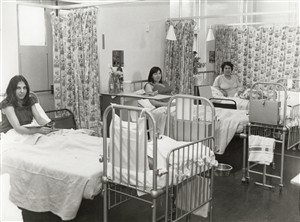Women in medicine 2

Mothers on the ward, c1970.
© St Bartholomew's Hospital Archive
A local perspective
The Mothers’ Hospital, a voluntary maternity hospital, was part of an extensive network of social provision provided by the Salvation Army in Hackney from the late 19th century. Formerly a home for unmarried women in Mare Street, this hospital opened in 1913 and during its early history employed an all-female staff. This was not common at the time, as most hospitals employed male doctors. There were other examples of all-female hospitals: the South London Hospital for Women and Children – a general hospital founded in 1912; and the Elizabeth Garrett Anderson Hospital which was the first general hospital to offer treatment to women by members of their own sex.
In the early 20th century the Mothers’ was at the front line of research into obstetrics (the surgical speciality of dealing with the care of women during pregnancy and childbirth), neonatal care and the treatment of sexually transmitted diseases. During this period the entire medical staff of the hospital consisted of women. It was a place where some of the leading female doctors practiced at the time. Well into the 1930s, during which the Mothers’ was flourishing in the hands of its all-female medical team, it was still common for other hospitals to still specify that women need not apply in their job advertisements in the British Medical Journal. The poverty and harsh social conditions of the women who used the Mothers’ Hospital provided good opportunities to study the effects of poor diet on pregnancy and children more generally.
In 1911, despite Marie Curie winning her second Nobel Prize in Chemistry, Helen Mackay (a doctor at the Mothers’ in the 1920s) had to listen to a lecture by the then President of the Royal College of Surgeons where he stated, in relation to Curie’s recent prize, that he believed women to be unsuitable for medical research. Another indication of how long it took for attitudes to change can be illustrated by another lecture at the London School of Medicine for Women in 1941. This time the President of the Royal College of Physicians, addressed the female students with the following statement: “medical women make excellent wives, while their qualification is always a second string to their bow.”
Against this background, it makes the achievements of the female doctors at the Mothers’ all the more impressive. It is no coincidence that the fields of paediatrics (the medical care of children) and neonatal medicine were chosen by a disproportionate number of women. In the 1920s and 1930s these were new specialisms where women could more easily break into the profession due to a lack of interest from male doctors.
All-women hospitals, set up by women, like the Mothers’, were crucial to the development of women’s medical careers. Most of the women who worked at the Mothers’ came from privileged backgrounds, unlike the many underprivileged women that they cared for. Many gave up the chance of marriage and family life in order to pursue their careers.
Back Next
This page was added by
Lisa Rigg on 24/03/2010.